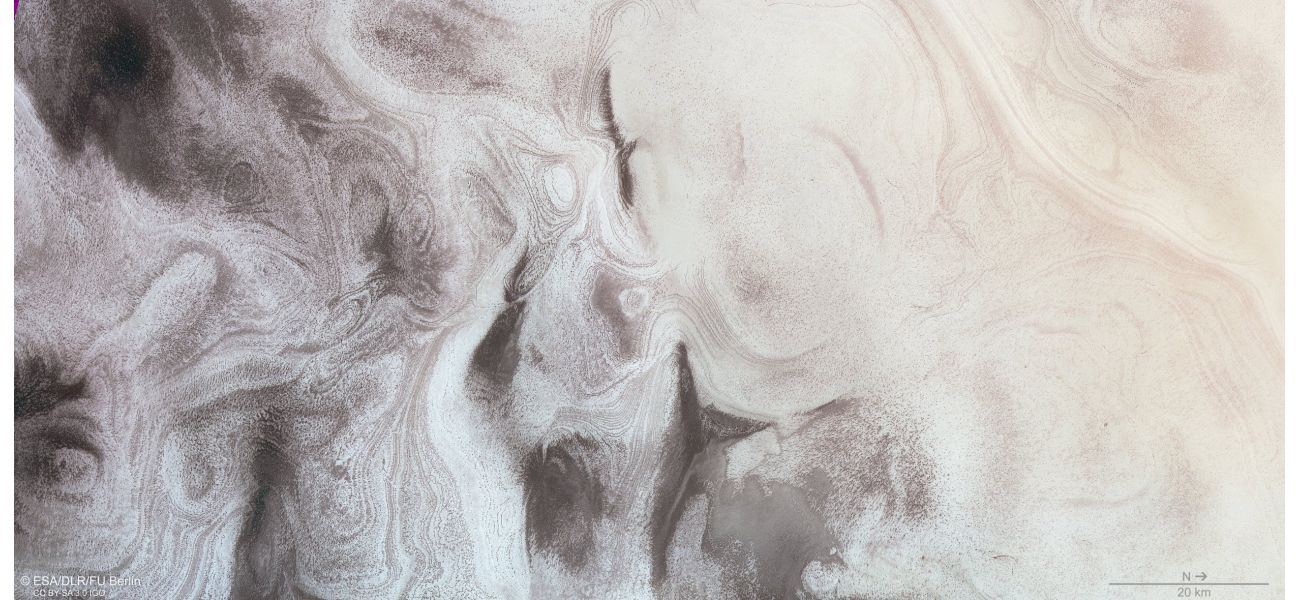Strange 'winter wonderland' sight seen 140 million miles away from us.
Stunning pictures of a snowy holiday season are taken from outer space.
December 26th 2024.

The beauty of a winter landscape is not limited to our own planet. In a place 140 million miles away from Christmas, on the surface of Mars, a 'winter wonderland' can be found. It may seem like a mysterious and enchanting place, but in reality, it is a region called Australe Scopuli, close to the south pole of the Red Planet.
At first glance, the images captured by the European Space Agency's Mars Express orbiter show a vast expanse of snowy terrain. The icy slopes are adorned with tight bends and smooth descents, making it seem like the perfect spot for a future space traveler to don their skis. However, the frigid temperatures and numerous dust jets that can reach up to hundreds of meters in height make it a challenging journey.
But what appears to be a blanket of snow is actually layers of carbon dioxide ice, measuring 26 feet thick at the south pole of Mars. These images were taken a few days before the Martian summer solstice, when temperatures can reach a high of 70F, a significant increase from the winter lows of -225F.
The dark patches on the ice are caused by the carbon dioxide ice sublimating, or turning from solid to gas, as the summer approaches. The sunlight causes the top layers to become translucent, allowing the gas to escape, carrying dark dust particles that eventually fall back onto the surface. This creates fan-shaped patterns, ranging from tens to hundreds of meters in size.
The stunning images were captured by the High Resolution Stereo Camera on the Mars Express orbiter in June 2022, and by the High-Resolution Imaging Science Experiment camera on NASA's Mars Reconnaissance Orbiter in September 2022. The European Space Agency described these scenes as a 'winter wonderland' at the south pole of Mars.
The agency explained that the swirls of carbon dioxide ice and dust layers give the Red Planet a white appearance. The stark contrast between light and dark layers is particularly striking on the exposed faces of hills and valleys. These layers are a result of seasonal polar deposits, formed as layers of ice freeze with varying amounts of dust trapped within.
Mars is often referred to as the Red Planet due to the presence of iron minerals in the soil that oxidize or rust. However, these images show a different side of Mars, one that is dry, rocky, and bitterly cold, according to NASA. As spring arrives on the planet, frost avalanches, carbon dioxide gas explosions, and powerful winds will occur as the ice thaws.
Serina Diniega, a planetary surface expert at NASA's Jet Propulsion Laboratory, stated that on Earth, spring brings the gradual melting of water ice, but on Mars, everything happens with a bang. This change in seasons also means that future space travelers may experience profound changes in space travel.
It is truly remarkable that these images were taken from a spacecraft that is almost 16,000,000,000 miles away from Earth, providing us with a glimpse of the mysterious depths of space. Who knows what other wonders we will discover as we continue to explore the vast universe around us.
At first glance, the images captured by the European Space Agency's Mars Express orbiter show a vast expanse of snowy terrain. The icy slopes are adorned with tight bends and smooth descents, making it seem like the perfect spot for a future space traveler to don their skis. However, the frigid temperatures and numerous dust jets that can reach up to hundreds of meters in height make it a challenging journey.
But what appears to be a blanket of snow is actually layers of carbon dioxide ice, measuring 26 feet thick at the south pole of Mars. These images were taken a few days before the Martian summer solstice, when temperatures can reach a high of 70F, a significant increase from the winter lows of -225F.
The dark patches on the ice are caused by the carbon dioxide ice sublimating, or turning from solid to gas, as the summer approaches. The sunlight causes the top layers to become translucent, allowing the gas to escape, carrying dark dust particles that eventually fall back onto the surface. This creates fan-shaped patterns, ranging from tens to hundreds of meters in size.
The stunning images were captured by the High Resolution Stereo Camera on the Mars Express orbiter in June 2022, and by the High-Resolution Imaging Science Experiment camera on NASA's Mars Reconnaissance Orbiter in September 2022. The European Space Agency described these scenes as a 'winter wonderland' at the south pole of Mars.
The agency explained that the swirls of carbon dioxide ice and dust layers give the Red Planet a white appearance. The stark contrast between light and dark layers is particularly striking on the exposed faces of hills and valleys. These layers are a result of seasonal polar deposits, formed as layers of ice freeze with varying amounts of dust trapped within.
Mars is often referred to as the Red Planet due to the presence of iron minerals in the soil that oxidize or rust. However, these images show a different side of Mars, one that is dry, rocky, and bitterly cold, according to NASA. As spring arrives on the planet, frost avalanches, carbon dioxide gas explosions, and powerful winds will occur as the ice thaws.
Serina Diniega, a planetary surface expert at NASA's Jet Propulsion Laboratory, stated that on Earth, spring brings the gradual melting of water ice, but on Mars, everything happens with a bang. This change in seasons also means that future space travelers may experience profound changes in space travel.
It is truly remarkable that these images were taken from a spacecraft that is almost 16,000,000,000 miles away from Earth, providing us with a glimpse of the mysterious depths of space. Who knows what other wonders we will discover as we continue to explore the vast universe around us.
[This article has been trending online recently and has been generated with AI. Your feed is customized.]
[Generative AI is experimental.]
0
0
Submit Comment





